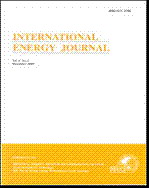ThaiScience
ThaiScience
INTERNATIONAL ENERGY JOURNAL
Volume 19, No. 02, Month JUNE, Year 2019, Pages 47 - 60
Assessment of thailand’s energy policy on co2 emissions: implication of national energy plans to achieve ndc target
Achiraya Chaichaloempreecha, Puttipong Chunark, Bundit Limmeechokchai
Abstract Download PDF
The industrial sector is one of the main energy-intensive sectors, and it accounted for 35.2% of total energy consumption in 2017. In terms of electricity consumption, the building sector was the largest electricity consuming sector, and it accounted for 57.4% of total electricity consumption in 2017. The objective of this paper is to assess the long-term energy policy in the building and the industrial sectors during 2005-2050 through a perspective of energy saving potentials and greenhouse gas (GHG) mitigation by using the Long-range Energy Alternative Planning system (LEAP). Results indicate that energy labeling and monetary incentive in the energy efficiency plan (EEP2015) and renewable energy plan (AEDP2015) are the most effective measures in the building and industrial sectors. This study discloses that plans are effective policies to reduce not only energy demand but also GHG emissions. Therefore, such reduction potentials can meet Thailand’s Nationally Determined Contributions (NDC) target. In 2050, the deployment of biogas will significantly reduce GHG emissions in the residential sector. The GHG emission reduction from the non-metallic, papers and pulps, and chemical industries will be diminished by the carbon capture and storage (CCS) technology in 2030 onwards. This study also considers energy security by focusing on economic and environmental aspects.
Keywords
buildings and industries, GHG emissions, EEP2015 and AEDP2015 plans, LEAP model, Thailand NDC.INTERNATIONAL ENERGY JOURNAL
Published by : Asian Institute of Technology
Contributions welcome at : http://www.rericjournal.ait.ac.th
